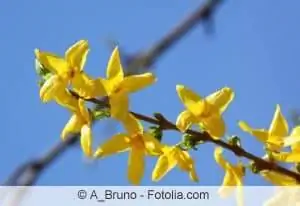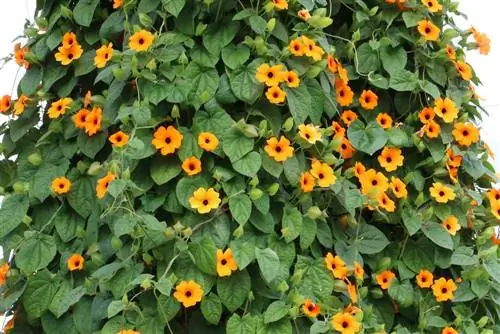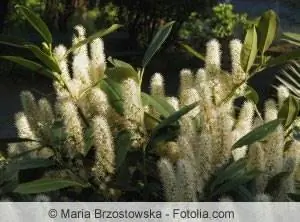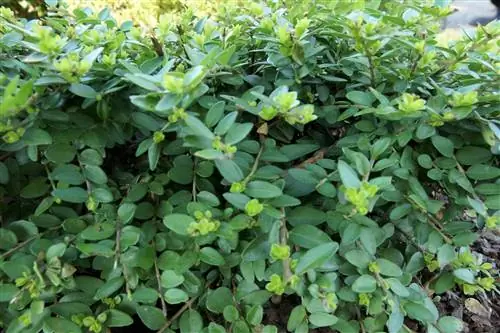- Author admin [email protected].
- Public 2023-12-17 03:39.
- Last modified 2025-06-01 06:48.
Unlike evergreen hedge plants, flowering hedge plants also delight the viewer's eye when they are in bloom. They are therefore also very suitable as path boundaries. It depends on your own taste whether you want to create a flowering hedge from the same plants or in a colorful mix. If you choose different flowering hedge plants, something can bloom in such a hedge all summer long.
Important aspects when creating flowering hedges
If you want to create a flowering hedge, you have to take their special needs into account when selecting suitable plants, just as with evergreen hedges. Therefore, before creating the hedge, pay attention to whether there is predominantly sun, partial shade or shade in this location and what the soil condition is like before selecting the plants. Your flowering hedge plants will only show their full blooms where they feel particularly comfortable.
You can create a flowering hedge from uniform plants. This hedge will only bloom at a certain time of the year and will otherwise, like any other evergreen hedge, serve as decoration with its foliage and also protect well from unwanted looks.
If you want something to bloom or look decorative in your flowering hedge almost all year round, you should mix the flowering hedge plants together. However, you still have to take into account that they are only plants that have the same needs in terms of lighting conditions and soil conditions.
Tip:
If you follow the following tips, you will definitely enjoy your flowering hedge.
For cutting a flowering hedge
Unlike evergreen hedges, when trimming a flowering hedge you must always remember that it cannot be trimmed at every time of the year. You can cut this type of hedge into shape in the spring, long before the first flowering branches appear, or in late autumn after the flowers have finished blooming.
The combination of flowering hedge plants
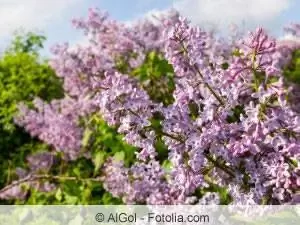
Not only the needs, but also the size of the flowering hedge plants are important when choosing plants. The bushes should match in size and growth so that your flowering hedge later creates a harmonious picture.
Suitable plants:
Strictly speaking, all shrubs are suitable as flowering hedge plants, which, in addition to the flowers, also form dense foliage and can tolerate being pruned regularly. These include, to name a few examples, gorse, forsythia, lilacs in all colors, apple roses, serviceberries or jasmine with single or double flowers. Deutzia, spars, bloodbarberries, butterfly trees and wig bushes are also very suitable for being part of a flowering hedge. The same applies to blood currants, marshmallows, hibiscus. Weigela or the devil's bush. Even without leaves, the dogwood still delights the eye in winter with its colorful wood. Wild roses are also a lot of fun as flowering hedge plants. Depending on the variety, they bloom sooner or later and, depending on the variety, also sprout their bright fruits, the rose hips, in the fall as additional hedge decoration.
What blooms at what time of year?
Some examples will now show when hedge plants can bloom.
The forsythia show their bright yellow flowers particularly early, making them one of the shrubs that make early spring so beautiful. Only a little later the bloodcurrant blooms and delights the eye with its red flowers. All types of service pears also bloom very early and then show their colorful fruits as a further decoration in June and July, some of which are similar to cultivated blueberries and are edible and very tasty. And because that's not enough to decorate the rock pear, later in autumn it delights the eye with its beautiful reddish foliage. The red dogwood in particular now stands out due to the contrast of the delicate green foliage with the red branches. However, it only shows its white flowers in June.
In May it can be the gorse in many different color variations, the wonderful lilac from white to soft lilac to dark purple or red and, in places with partial shade, the richly blooming rhododendron that enchant the flowering hedge. Then there are the weigelias with their beautiful flowers from soft pink to dark red and the splendor of the white-flowering deutzia. In May, the bloodbarberries also show their bright yellow flowers between the dark red leaves of these hedge plants.
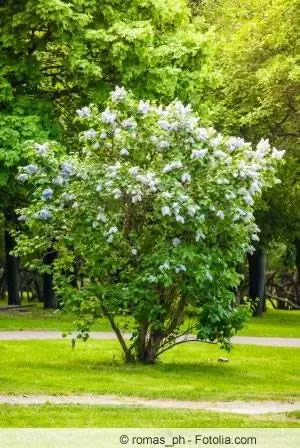
Many types of roses, which are particularly suitable as hedge plants when it comes to wild roses, only begin to bloom at the end of May or beginning of June and later, but they bloom for a very long time and often until late summer. Shortly after flowering, the bright red rose hips appear, which often make a flowering hedge catch the eye until late autumn.
Later in the year, usually starting in July and continuing into September, the hibiscus, the butterfly trees and the devil's bush show their colorful flowers in the flowering hedge. At this time of year, countless butterflies cavort in hedges with butterfly trees in them, as these plants got their name for this reason. The delicate flowers of the wig bush, which can appear as early as February if the starting location is well chosen, can still be seen there.
Which plants are suitable?
- Forsythia IV - V / yellow (also white varieties) / w/h 2 - 3m
- Hibiscus syriacus VIII - IX / white, pink, purple / w/h 2 - 3m
- Bloodcurrant IV - V / pink / w/h 2m
- Ball hydrangea VI - CIII / white / w/h 2.5m
- Kolkwitzie/Mother-of-Pearl Bush V - VI / white/pink / w/h 4 / 3 m
- Pipe bush/summer jasmine VI / white / w/h 2.5 / 3m
- Deutzia/lily of the valley V - VI / white / w/h 0.5 -2 / 0.5 -4m
- Weigela V / mostly red, pink / w/h 1 - 2, 5m depending on variety
- Lilac V / white, pink, purple / w/h 3 / 4m
- Yellow bubble bush V - IX / yellow / w/h 2 - 3m
- Kerrie/ranunculus bush IV - V /yellow / w/h 1 -2m
- Splendid spar IV - V white / w/h 4/4-6m
- Shrub Spiere IV - VIII (depending on the variety / mostly pink / w/h on average 1.5 m, strongly dependent on the variety
- Buddleia VII - IX white, yellow, pink, hot pink, light blue, purple, dark purple / w/h 3m
- Rock pear, copper rock pear IV - V white / w/h 8 -10 m
- Common pea bush V yellow / w/h 8m
- Ornamental quince/mock quince III - IV strong pink / w/h 2/1, 5m
- Hard rose/wild rose VI /white to slightly pink, also pink types/ w/h 3 - 5m
- Blackthorn III - IV / white / w/h 3m
- Elderberry V - VI / white / w/h 1 - 7 / up to 5m
- Mahonie IV / yellow / w/h 1 - 2m
- Firethorn V - XI /white / w/h 3m
- Sea buckthorn IV / yellow-brown / w/h 6m
Caring for a flowering hedge
The plants should be chosen to suit the location (soil conditions and sunlight). If that's right, they don't require much care. Here's what you should pay attention to:
- Flowering hedges are best planted in spring or autumn.
- Planting spacing and arrangement: The hedge looks nicer if all the plants are not placed exactly in a row, but rather the stronger growing ones are placed a little back and the weaker growing ones are placed a little forward.
- Water well after planting. Water well over the next few months (especially when planting in spring) until the bushes have grown.
- Fertilize once with slow-release fertilizer and in late summer with potash and phosphorus fertilizer.
Cutting a flowering hedge
If you have space, you can simply let a flowering hedge grow. Then it looks particularly natural. If there are plants with thorns and spines in the hedge, you have to be careful that they don't spread too much. Otherwise it will make your work more difficult when pruning plants - and it may also be difficult to get to the neighboring bushes, e.g. B. when harvesting berries. All gardeners who don't have that much space are almost automatically forced to train the hedge, ideally right from the start.
- Flowering shrubs that bloom early in the year are cut immediately after flowering.
- Flowering shrubs that bloom in summer or autumn should be cut in early spring or late winter, always before budding begins.
- Most winter-flowering shrubs such as viburnum varieties or witch hazel do not like pruning.
Variety tips for flowering hedge plants
- The ranunculus bush blooms twice a year, once in spring from April to May and then again in July/August. In winter the plant is leafless, but has beautiful green branches. In addition, it sprouts again early.
- The bridal spar blooms in April, is white and is so dense that it remains very opaque even in winter without leaves. The plant is very undemanding and flowers profusely. The magnificent spar is similar and only blooms a little later.
- The weigela usually blooms in May in a beautiful pink color. The plants grow outward and overhanging. The flowers have a beautiful shape and often a striking color.
- The false jasmine impresses with its numerous, white, fragrant flowers. It blooms in June. The plant grows quite quickly, but can be easily pruned.
- The firethorn has evergreen leaves, making it an ideal hedge plant. It blooms in June and the berries ripen in September/October. Depending on the variety, they can be yellow, orange or red. The firethorn has long thorns, so be careful if you have small children.
- The yew is one of the most noble hedge plants. It thrives on almost all soils and is easy to care for and tolerates cutting. The flowers are rather inconspicuous. However, almost all parts of the plant (needles, seeds, wood and bark) are poisonous, so be careful with children. The berries are very tempting.
- The cherry laurel has the advantage of being evergreen. It grows quickly and can be pruned well. The flowers are striking and look very beautiful.
- The snowberry, purple berry or also known as the snap pea bush, blooms in June and carries its berries until winter. They are white or pink depending on the variety.
- Forsythia is also often used as a hedge. In spring their flowers shine and make them an ornament in every garden. The rest of the year it is a normal hedge of leaves until the leaves fall off in autumn.
Mixed flowering hedges are popular. It contains honeysuckle, serviceberry, viburnum, elderberry, bloodcurrant or ornamental currant, summer jasmine, forsythia, tamarisk and various types of lilac, including buddleia. The appeal of these hedges lies in the harmonious mix. You shouldn't overdo it with biodiversity. Repetitions create a rhythm in planting. There are decorative flowering trees from early spring to late autumn.
Before you decide on one or more types of hedge plants, you should check the site conditions. Different plants have different requirements. You should also consider how much space they will need in a few years. Not all of them are suitable for a good cut. You should keep that in mind.
Summary for speed readers
- Flowering hedge plants can be chosen uniformly or in a colorful mix.
- When selecting species, you should pay attention to the soil conditions and lighting conditions.
- When putting together the hedge, consider when the shrubs will bloom.
- The care of the plants depends on the respective species.
- Pruning such a hedge is only possible in early spring or late autumn.
Frequently asked questions
How should a flowering hedge be cared for?
That's not easy to answer. It depends on the flowering hedge plants that are in this hedge which care is best and must therefore always be based on the corresponding species.
Which planting distance is best?
There is no general answer here either. If you create a flowering hedge, the planting distance should always depend on the hedge plants you choose and should be chosen individually.

